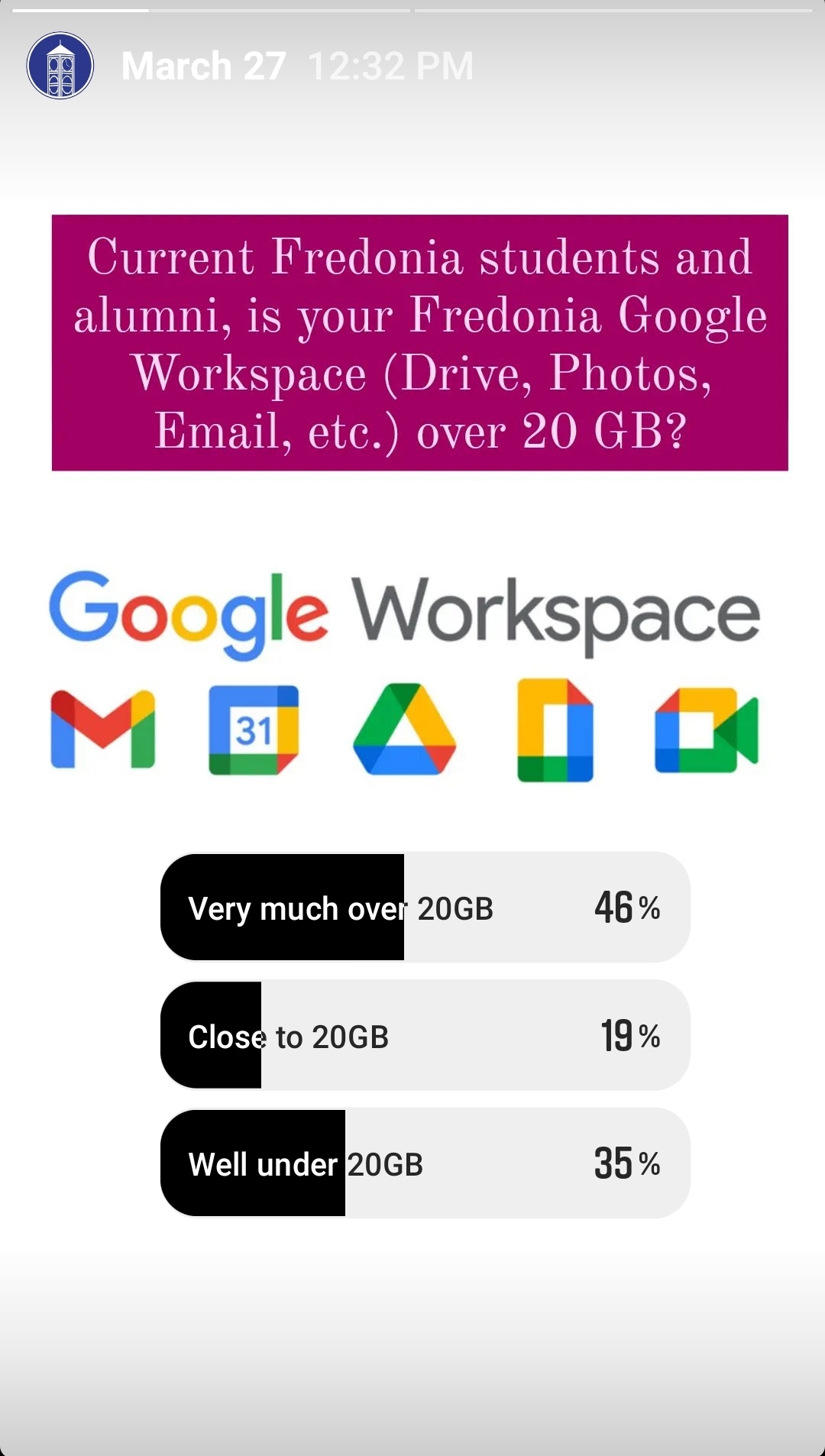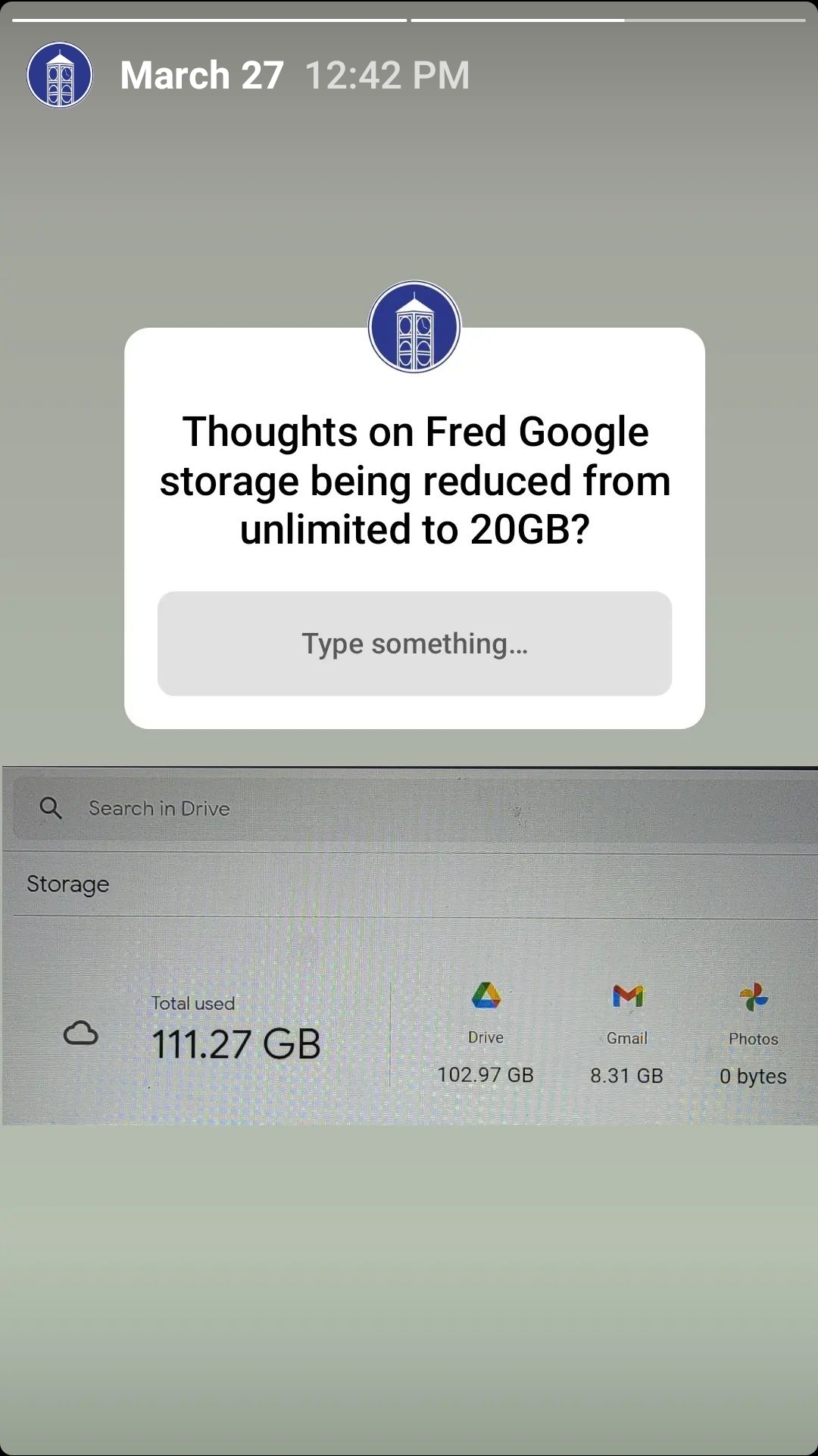

Google recently announced a reduction in the storage limits of Google Workspace for Education accounts from unlimited storage to 20GB. This will be effective July 1, 2022 and impacts current students, professors, faculty, alumni and emeritus.
See “What you need to know: SUNY Fredonia Google Workspace storage reduction and account deletion.”
The Leader asked Fredonia alumni and current student followers through an Instagram poll (@leaderfredonia) if their Fredonia Google Workspace accounts were over 20GB. The results: 46% (22 users) voted for “very much over 20GB,” 19% (9 users) voted for “close to 20GB” and 35% (17 users) voted for “well under 20GB.”
An open-ended question on alumni and current students’ thoughts on the soon-to-be implemented storage quota was posted on the Instagram story as well. Nine users expressed frustration at the thought of organizing and moving files, including two self-identified alumni. One user commented on the seemingly simple solution of moving files to a hard drive.
This announcement has varying levels of impact on different departments. Liz Lee, a VANM photography professor of Fredonia for 22 years, heavily relies on Google Drive to teach her classes. High quality photo files are too large to upload to OnCourse directly, but the option to link to Google Drive in OnCourse submissions allows students to still upload huge files. Another advantage of Google Drive is that professors and students can share folders with each other, which allows students to critique their peer’s work even in a remote course, according to Lee.
Although it is possible for Lee to transfer files from Google Drive to OneDrive, it will take quite a long time. Lee filled a work-issued laptop she got in 2017 with a 256GB storage twice. Thus, her Fredonia Google Drive contains around half a terabyte of files — again, OneDrive offers one terabyte of data. One of Lee’s student’s is already over a terabyte of storage in Google Drive and is “panicking.”
In addition to the alternative cloud storage options suggested by ITS, students and professors can also purchase personal harddrives, as was pointed out by a user on Instagram. But hard drives are not as efficient from an online class perspective.
“I can’t use my hard drive remote…. You can’t send me your TIFF files from Intro to Digital Photography to my hard drive. You have to either email it to me or put it on a cloud storage space of some sort. And I feel like since that is part of the institution and part of education, [storage] should be provided by the institution,” Lee expressed during a Zoom interview.
OneDrive may be a supplement to Google Drive for sharing capacities, but it is not already embedded into OnCourse. This has an uncertain impact on Lee’s classes because OnCourse, SUNY Fredonia’s current learning management system, is set to be replaced by D2L Brightspace starting Summer 2023, according to “Transition to the New DLE is Underway” on dle.suny.edu/. (See paragraph on bottom of article for more information.)
Alex Erwin, a junior double majoring in audio/radio production and video production, currently has 140GB in his Fredonia Google Drive. “I have 20GB just for my audio capstone class, Sound Design, and easily 100GB just for [the club] Fredonia Radio Systems files. We use Drive to share files between departments and critique work both at the [radio] station and in class. It’s honestly integral to my majors to have a file sharing service like this,” Erwin explained via email.
Erwin is “both upset and angry” with the soon-to-be quota on Google Workspace storage. “I acknowledge OneDrive is an option, but it’s not as versatile as Google Drive. And for some stuff, like the [Fredonia Radio Systems Archiving Project], one terabyte still isn’t enough. We need unlimited [storage] to deal with the amount of content we create.”
Erwin further expressed he wanted the university to “offer unlimited accounts that groups of students can access, such as one for theatre production and one for the radio station … to allow us to continue honing our craft efficiently.”
During the “How Technology Changes Education” from the Brown Bag Lecture Series on March 2, presenter Lisa Melohusky, SUNY Fredonia Online Learning Coordinator, explained how technology changes are either forced or welcomed, and that throughout the university’s history, there has been a combination of both reactions.
For example, Fredonia switched from Collaborate, a video communication software used by professors during the beginning of the pandemic, to Zoom. Many professors wanted to use Zoom as the program was less “clunky,” as Melonhusky described it, and therefore this change in technology was welcomed.
The introduction of Google Workspace and FredMail to replace Microsoft Outlook was a forced change that faculty were resistant to — they had to relearn an email system so the university could save money.
Melonhusky explained that adding programs from the G-Suite like Google Docs changed the way content was delivered to students because of the sharing capacities available within Google programs. She explained that after faculty were given time and training to understand Google Workspace, the campus has become “hard-pressed to function day-to-day without it because we have found a way to help with it.”
When it comes to technological changes, Melonhusky emphasized people need to be patient, persistent, practical and positive in general. Technological changes are inevitable and are implemented with the intention of bettering the campus.
Transition from OnCourse to D2L Brightspace
OnCourse, SUNY Fredonia’s current Learning Management System (LMS) operated by Moodle, is set to transition to Desire2Learn’s (D2L) Brightspace.
According to Lisa Melonhusky, SUNY Fredonia Online Learning Coordinator, the decision to transition was made by SUNY rather than SUNY Fredonia. SUNY decided all 64 of its campuses should be on the same LMS in order to centralize its online learning environment. After research on different LMS and a request for proposal, the Office of the New York State Attorney General and the Office of the New York State Comptroller has approved the contract between SUNY and D2L.
According to “Transition to the New DLE is Underway” on dle.suny.edu, there will be a “multi-month process that involves academic and technical planning, training, testing and piloting before all of its courses/activities are live in the production environment.”
The webpage further explains the estimated time for completion is a range between 11 and 13 months. SUNY Fredonia is set to begin the transition in September 2022 with the D2L Brightspace going live around August 2023. Thus, summer semester 2023 is when students are expected to start using Brightspace.
